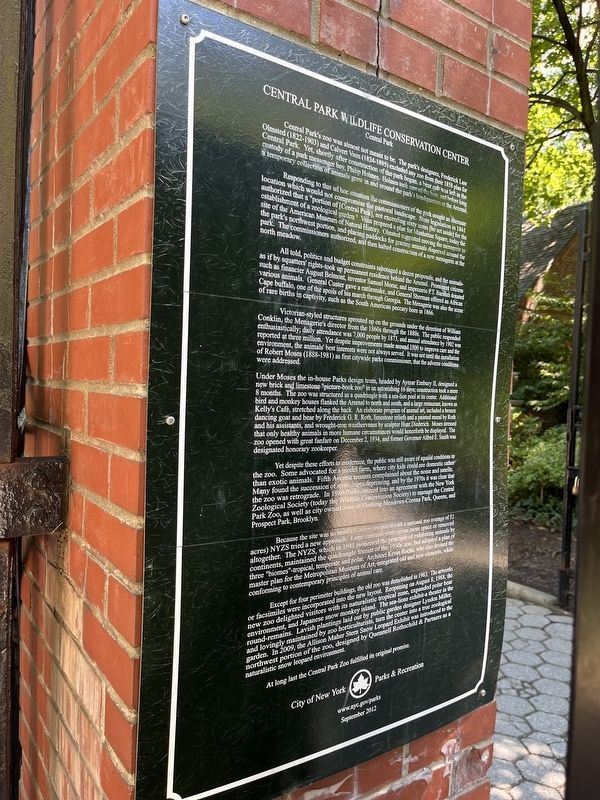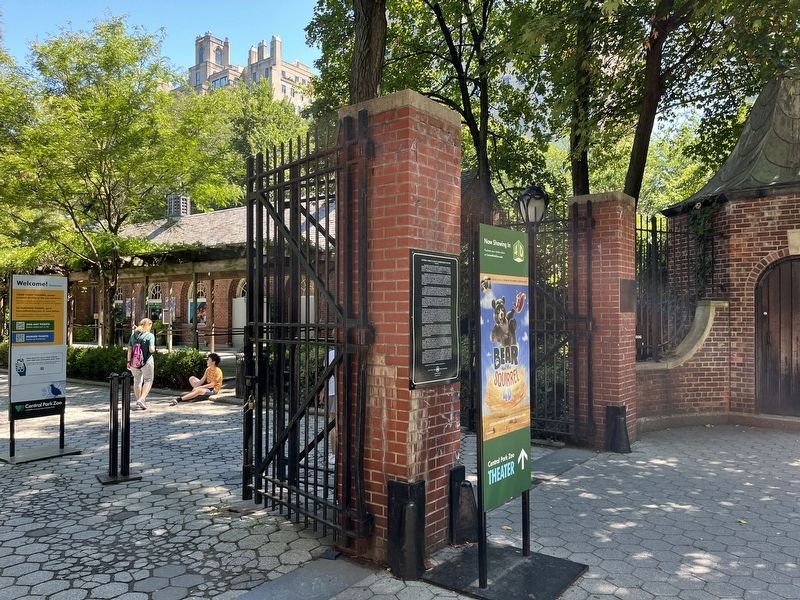Central Park West Historic District in Manhattan in New York County, New York — The American Northeast (Mid-Atlantic)
Central Park Wildlife Conservation Center
Central Park

Photographed By Devry Becker Jones (CC0), August 12, 2022
1. Central Park Wildlife Conservation Center Marker
Central Park's zoo was almost not meant to be. The park's designers, Frederick Law Olmsted (1822-1903) and Calvert Vaux (1824-1895) excluded any zoo from their 1858 plan for Central Park. Yet, shortly after construction of the park began, a bear cub was left in the custody of a park messenger boy, Philip Holmes. Holmes took care of the bear, and before long a temporary collection of animals grew in and around the park's headquarters at the Arsenal.
Responding to this ad hoc situation the commissioners of the park sought an alternate location which would not compromise the pastoral landscape. State legislation in 1861 authorized that a "portion of [Central Park], not exceeding sixty acres [be set aside] for the establishment of a zoological garden" Vaux prepared a plan for Manhattan Square, today the site of the American Museum of Natural History. Olmsted suggested moving the menagerie to the park's northwest portion, and placing paddocks for grazing animals dispersed around the park. The commissioners authorized, and then halted construction of a new menagerie at the north meadow.
All told, politics and budget constraints sabotaged a dozen proposals, and the animals—as if by squatters' rights—took up permanent residence behind the Arsenal. Prominent citizens such as financier August Belmont, inventor Samuel Morse, and impresario P.T. Barnum donated various animals. General Custer gave a rattlesnake, and General Sherman offered an African Cape buffalo, one of the spoils of his march through Georgia. The Menagerie was also the scene of rare births in captivity, such as the South American peccary born in 1866.
Victorian-styled structures sprouted up on the grounds under the direction of William Conklin, the Menagerie's director from the 1860s through the 1880s. The public responded enthusiastically; daily attendance was 7,000 people by 1873, and annual attendance by 1902 was reported at three million. Yet despite improvements made around 1900 to improve care and the environment, the animals' best interests were not always served. it was not until the installation of Robert Moses (1888-1981) as the first citywide parks commissioner, that the adverse conditions were addressed.
Under Moses the in-house Parks design team, headed by Aymar Embury II, designed a new brick and limestone "picture-book zoo" in an astounding 16 days; construction took a mere 8 months. The zoo was structured as a quadrangle with a sea-lion pool at its center. Additional birth and monkey houses flanked the Arsenal to north and south, and a larger restaurant, known as Kelly's Café, stretched along the back. An elaborate program of animal art, included a bronze dancing goat and bear by Frederick

Photographed By Devry Becker Jones (CC0), August 12, 2022
2. Central Park Wildlife Conservation Center Marker
Yet despite these efforts to modernize, the public was still aware of squalid conditions in the zoo. Some advocated for a model farm, where city kids could see domestic rather than exotic animals. Fifth Avenue tenants complained about the noise and smells. Many found the succession of spare cages depressing, and by the 1970s it was clear that the zoo was retrograde. In 1980 Parks entered into an agreement with the New York Zoological Society (today the Wildlife Conservation Society) to manage the Central Park Zoo, as well as city owned zoos in Flushing Meadows-Corona Park, Queens, and Prospect Park, Brooklyn.
Because the site was so small (5 acres compared with a national zoo average of 52 acres) NYZS tried a new approach. Large animals were given more space or removed altogether. The NYZS, which in 1941 pioneered the principle of exhibiting animals by continents, maintained the quadrangle format of the 1930s zoo, but adopted a plan of three "biomes"–tropical, temperate and polar. Architect Kevin Roche, who also devised the master plan for the Metropolitan Museum of Art, integrated old and new elements, while conforming to contemporary principles of animal care.
Except for four perimeter buildings, the old zoo was demolished in 1983. The artworks or facsimiles were incorporated into the new layout. Reopening on August 8, 1988, the new zoo delighted visitors with its naturalistic tropical zone, expanded polar bear environment, and Japanese snow monkey island. The sea-lions exhibit—a theater in the round—remains. Lavish plantings laid out by public garden designer Lynden Miller, and lovingly maintained by zoo horticulturists, turn the center into a true zoological garden. In 2009, the Allison Maher Stern Snow Leopard Exhibit was introduced to the northest portion of the zoo, designed by Quennell Rothschild & Partners as a natrualistic snow leopard environment.
At long last the Central Park Zoo fulfilled its original promise.
Erected 2012 by City of New York Parks & Recreation.
Topics and series. This historical marker is listed in these topic lists: Animals • Parks & Recreational Areas. In addition, it is included in the NYC Parks series list. A significant historical date for this entry is December 2, 1934.
Location. 40° 46.016′ N, 73° 58.323′ W. Marker is in Manhattan, New York, in New York County. It is in the Central Park West Historic District. Marker is on Park Road, 0.1 miles north of Grand Army Plaza, on the left when traveling north. Touch for map. Marker is at or near this postal address: 112 5th Ave, New York NY 10065, United States of America. Touch for directions.
Other nearby markers. At least 8 other markers are within walking distance of this marker. The Arsenal (about 300 feet away, measured in a direct line); a different marker also named The Arsenal (about 300 feet away); Knickerbocker Club (about 300 feet away); Meet Our Bears (about 500 feet away); Studying Grizzly Clues / From Clues to Conservation (about 500 feet away); Native New Yorkers (about 500 feet away); We're Committed to Saving Snow Leopards (about 600 feet away); Lehman Gates (about 700 feet away). Touch for a list and map of all markers in Manhattan.
Credits. This page was last revised on January 31, 2023. It was originally submitted on August 15, 2022, by Devry Becker Jones of Washington, District of Columbia. This page has been viewed 85 times since then and 10 times this year. Photos: 1, 2. submitted on August 15, 2022, by Devry Becker Jones of Washington, District of Columbia.